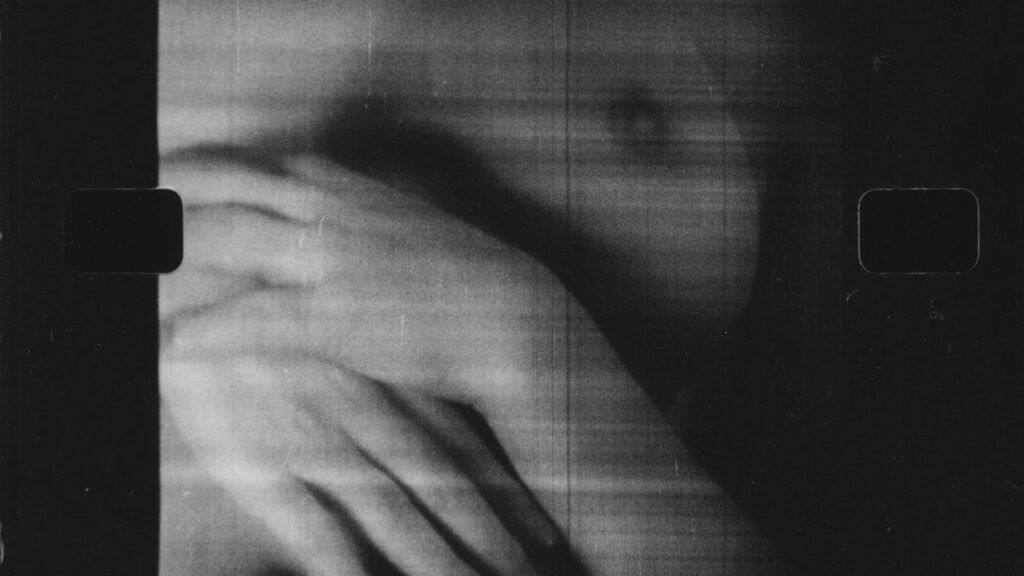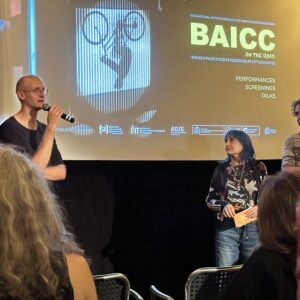Paolo Gioli, one of our most admired filmmakers and inventors, passed away in 2022 without us having had the opportunity to invite him to A Coruña. Now we are reviving him through his cinema in a programme in memoriam prepared and presented by Enrico Camporesi, an expert on his work. To complement it, here is a fragment of the text by Jean-Michel Bouhours, also a filmmaker, that appeared in the catalogue of the exhibition “Paolo Gioli. Fotografie, dipinti, grafica, film” curated by Roberta Valtorta in Il Palazzo delle Esposizioni in Rome in 1995-96.

From The Man with a Movie Camera to The Man without a Movie Camera
From the acquisition of his first Bolex, Gioli conferred on the apparatus extensive functions: shooting, special effects, even printing as had the first Lumière cameramen. The apparatus becomes for the artist a portable studio, a small traveling lab permitting shooting, compositing images and their chemical developing in an integrated and independent process, whatever the circumstance. This return to cinematic primitivism did not originate in an ideological bias, but was rather the revenge of an artist on technology, in which the latter would be made the echo of his inventiveness, taking up the project articulated by Theo Van Doesburg but rarely realized, of the necessary adaptation of cinematic technology to visual dynamism.
And there is no known photographic technology that Gioli has not applied to the cinema. For example, the process of “photo-finish” derived from the photodynamism of Antonio Bragaglia, with which he creates anamorphoses of bodies giving results close to those of Ducos du Hauron, would produce in the cinema Film finish (1986-89), a film with a double existence: as beautiful to examine as a film strip as in conventional projection. In the same way, the artist would adopt for his films the technique of pinhole photography mastered by him in 1969, surpassing all previous experiments which had previously attempted to surpass the constraints of technology. A number of experimental filmmakers have subverted the range of what the tool might have been able to impose in the way of artist academicism. Marie Menken forced the recognition of the expressive qualities of shaky images taken with a hand-held camera; Jonas Mekas imposed the aesthetic of the over- or underexposure of images, refusing to use a light meter and in the process sharpening his eye; Stan Brakhage, finally, in one of the primary works of the underground cinema, Metaphors on Vision, gave several suggestions for finishing off in the cinema the first stages of pictorial Impressionism, denouncing this “post card effect (salon painting).” These are among the most famous landmarks of the liberation of the modern artist from the cinematographic tool and from the conventions attached to its use. These different modalities nonetheless pass through recourse to the camera and its possibilities for intervention in the process of shooting: frame rates, filters, exposure, etc. The motion picture camera becomes a sort of hat for the filmmaker, who is transformed into a magician.
But none went so far as Gioli in proposing alternative constructions of motion picture camera! Gioli utilizes pinhole photography, a mechanism of the camera obscura permitting the formation of an image, without the aid of a lens, inside the camera body, which has been pierced by a small hole through which light passes. With L’uomo senza macchina da presa [Man without a Movie Camera], a pinhole film dedicated to Dutch scientist Rainer Gemma Frisius, Gioli transports us to an elsewhere, an imaginary world in the heart of the mechanisms of perspective, where the miracle of nature of the formation of images occurs; as if suddenly we were immersed in an immense camera obscura. Isn’t this the return to the primordial world of Cézanne, that Merleau Ponty called the first philosophical act, the return to the world of experience prior to the objective world? Distant indeed from the post-card effect of which Brakhage speaks, we experience a childlike marvel at frail, fragile images. The replacement of the motion picture camera by a long tube with 150 pinhole perforations, each of which registers one of 150 frames of film, imposes on the filmmaker short repetitive sequences the filmmaker will turn to his advantage. The displacement of the point of view imposed by the tube, produced on the nude body of a female model, produces a strong erotic charge; this movement of a reiterative vision deceives us. As a kind of subliminal image, the neck of the young woman appears between her thighs at the moment the film loops, suddenly taking on phallic aspects. A mirage? An optical effect? Gioli brings us back to lucidity when confronted by artifice. By way of allusion to Dziga Vertov’s antithetical Man with a Movie Camera, Gioli, the experimentalist, demonstrates with his Man without a Movie Camera, that the artist possesses the means for a total mastery of his mechanisms. With the pinhole technique—where any kind of object can serve as the camera obscura, from a kitchen utensil to the buttons on a jacket, from salted crackers to the artist’s own hand— Gioli takes up one of the essential artistic problematics of the second half of the century: the body as a vector of psychic automatism or interface between the psyche and the work. We are clearly at the center of contemporary artistic problematics. Is it necessary for us to repeat it? The work of Paolo Gioli clearly has nothing to do with some vague nostalgia for the past. Gioli, like Brakhage, and many others, pursues an unprecedented vision in which the image is no longer the analogon of the thing represented, but rather the metonymy (a visual trope) of a mental process.
Cinema and mental constructs
Gioli, similarly to Stan Brakhage in this regard, articulates his visual works from two points of reference: the philosophical thought of Ludwig Wittgenstein, on the one hand, and the literary work of Gertrude Stein, on the other. Like the texts of the celebrated collector and friend of Picasso, the iconic constructions of Gioli have meaning only as mental mechanisms. Traumatografo [Traumatograph] is characteristic of this attempt to represent a psychological state, a drive. The images are presented in symbolic fashion, outside all discursive logic. Only death, fatal outcome and perfectly representable reality, will be staged, dramatized by an arrested image from a sequence of a driver thrown through a window accompanied by the ringing of a telephone. The calling into question of figurative representation—Darstellung—for Wittgenstein, explored in detail in the Philosophical Investigations serves as a kind of Ariadne’s thread in the work of Gioli: the manipulation of his images, the alternation of positive and negative, the effects of matting images, the charged quality (Prägnanz) of the subject matter, the erratic movements of the images all confirm this permanent quest for the relationship between the cogito and the imago, the presentation of which he stages, for example, in a sequence of Il volto inciso [The Graven Face], where the cinematographic image is projected onto the face of the person being filmed. Gioli here juxtaposes the image and its mental perception—transmitted to us as spectators—by means of the grimaces or mimetic actions of the actor. The images of Paolo Gioli refuse a contingent orthonormal and isomorphic representation of physiological vision; they are, in the iconic domain, what the eructations of Antonin Artaud were in language, the surpassing, dear to Wittgenstein, of the surpassing of oneself.
Problems in perspective
Walter Benjamin brought our attention—and before him Luigi Pirandello—to this similitude of the filmed image and the image reflected back to us by a mirror. This latter, on the other hand, establishes a personal relation, an intimate one, just where the cinema will displace this image towards the audience. For Gioli, this is a recurrent question in his work with the mirror as a paradigmatic figure. His recourse to primitive mechanisms, to the images of his precursors is most probably a means of making a judgement on the state of the image today. For if Gioli turns to the renaissance mechanism of perspectiva artificialis and to the camera obscura—the instrumental prototype of modern vision—is it by way of fascination with the past, or in order to affirm a critical position on the aporia of analogical representation, of which Baudelaire made himself the eulogist in a review of the salon of 1859, the exhibition where for the first time photography was presented.9 The response allows no ambiguity. The filmmaker revisits the mechanism of perspective as logocentric rationalism, which has little interest in the teleology of light dear to Gioli.10 He makes reference to the perspective device of the tavoletta of Brunelleschi in Immagini disburbate…, in a photo-montage where the gaze of the spectator is materialized by a particular angle of vision. This visual cone is seized by a copulatory movement of the eye, which would not have displeased Georges Bataille, the author of the 1928 Histoire de l’oeil [Story of the Eye], nor the sculptor of the celebrated pointe à l’oeil [spike for the Eye], Alberto Giacometti.
This entire problem of perspectival representation could only lead Gioli to an interest in the impossible worlds of Maurits Cornelis Escher, to whom he would dedicate a film in 1991, Metamorfoso [Metamorphosis]. There is no need to recall that Escher, like Gioli, dedicated himself to demonstrating through impossible constructions, the imposture of renaissance perspective. We can find here again then some analogies between screens in the work of Gioli and Escher’s simultaneous spaces. Finally Escher represents an exciting alternative to pre-cinema, for a representation of movement in sequences of still images. Gioli worked from plates where two spaces or two worlds were intermingled; the dissolution of one in the other, in spite of the static figures, is related to the lap dissolve in film11 and the filmmaker attempts to demonstrate in this film the links between movement and static representation in a metamorphosis.






